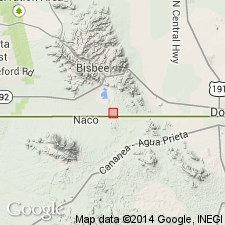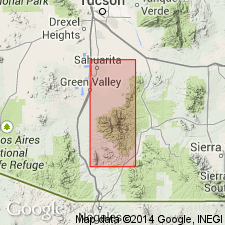
- Usage in publication:
-
- Fort Buchanan formation
- Modifications:
-
- Original reference
- Dominant lithology:
-
- Conglomerate
- Sandstone
- Shale
- AAPG geologic province:
-
- Basin-and-Range province
Summary:
Pg. 59. Fort Buchanan formation of Sonoita group. Consists of a basal conglomerate about 400 feet thick overlain by a series of alternating hard gray sandstones and soft maroon shales approximately 1,500 feet thick. The lower division of Sonoita group; underlies Fort Crittenden formation (new). Rests on andesitic flows. Age is Late Cretaceous.
Notable exposures in Casa Blanca Canyon, Patagonia Mountains, southeastern AZ. Name adopted from the nearby ruins of an old fort.
Source: US geologic names lexicon (USGS Bull. 1200, p. 1392).

- Usage in publication:
-
- Fort Buchanan Formation*
- Modifications:
-
- Not used
Summary:
Fort Crittenden adopted. Fort Crittenden and Fort Buchanan Formations were named as formations in Sonoita Group. Neither Fort Buchanan nor Sonoita used in report area which covers the Santa Rita Mountains of southern Pima Co., Basin-and-Range province, and northern Santa Cruz Co., Pedregosa basin, AZ. Author recommends Fort Buchanan and Sonoita be "dropped" from stratigraphic nomenclature.
Source: GNU records (USGS DDS-6; Denver GNULEX).
For more information, please contact Nancy Stamm, Geologic Names Committee Secretary.
Asterisk (*) indicates published by U.S. Geological Survey authors.
"No current usage" (†) implies that a name has been abandoned or has fallen into disuse. Former usage and, if known, replacement name given in parentheses ( ).
Slash (/) indicates name conflicts with nomenclatural guidelines (CSN, 1933; ACSN, 1961, 1970; NACSN, 1983, 2005, 2021). May be explained within brackets ([ ]).

